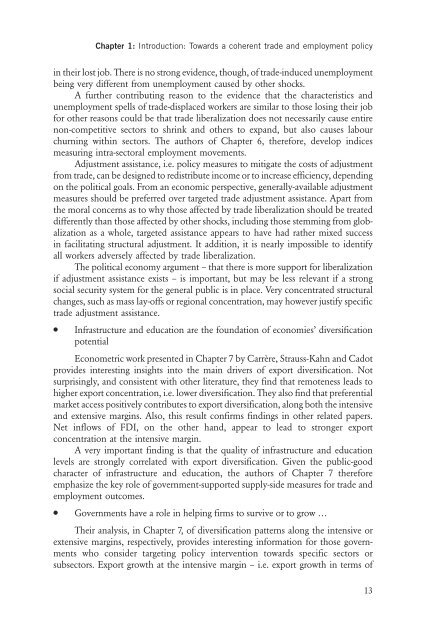Trade and Employment From Myths to Facts - International Labour ...
Trade and Employment From Myths to Facts - International Labour ...
Trade and Employment From Myths to Facts - International Labour ...
You also want an ePaper? Increase the reach of your titles
YUMPU automatically turns print PDFs into web optimized ePapers that Google loves.
Chapter 1: Introduction: Towards a coherent trade <strong>and</strong> employment policy<br />
in their lost job. There is no strong evidence, though, of trade-induced unemployment<br />
being very different from unemployment caused by other shocks.<br />
A further contributing reason <strong>to</strong> the evidence that the characteristics <strong>and</strong><br />
unemployment spells of trade-displaced workers are similar <strong>to</strong> those losing their job<br />
for other reasons could be that trade liberalization does not necessarily cause entire<br />
non-competitive sec<strong>to</strong>rs <strong>to</strong> shrink <strong>and</strong> others <strong>to</strong> exp<strong>and</strong>, but also causes labour<br />
churning within sec<strong>to</strong>rs. The authors of Chapter 6, therefore, develop indices<br />
measuring intra-sec<strong>to</strong>ral employment movements.<br />
Adjustment assistance, i.e. policy measures <strong>to</strong> mitigate the costs of adjustment<br />
from trade, can be designed <strong>to</strong> redistribute income or <strong>to</strong> increase efficiency, depending<br />
on the political goals. <strong>From</strong> an economic perspective, generally-available adjustment<br />
measures should be preferred over targeted trade adjustment assistance. Apart from<br />
the moral concerns as <strong>to</strong> why those affected by trade liberalization should be treated<br />
differently than those affected by other shocks, including those stemming from globalization<br />
as a whole, targeted assistance appears <strong>to</strong> have had rather mixed success<br />
in facilitating structural adjustment. It addition, it is nearly impossible <strong>to</strong> identify<br />
all workers adversely affected by trade liberalization.<br />
The political economy argument – that there is more support for liberalization<br />
if adjustment assistance exists – is important, but may be less relevant if a strong<br />
social security system for the general public is in place. Very concentrated structural<br />
changes, such as mass lay-offs or regional concentration, may however justify specific<br />
trade adjustment assistance.<br />
● Infrastructure <strong>and</strong> education are the foundation of economies’ diversification<br />
potential<br />
Econometric work presented in Chapter 7 by Carrère, Strauss-Kahn <strong>and</strong> Cadot<br />
provides interesting insights in<strong>to</strong> the main drivers of export diversification. Not<br />
surprisingly, <strong>and</strong> consistent with other literature, they find that remoteness leads <strong>to</strong><br />
higher export concentration, i.e. lower diversification. They also find that preferential<br />
market access positively contributes <strong>to</strong> export diversification, along both the intensive<br />
<strong>and</strong> extensive margins. Also, this result confirms findings in other related papers.<br />
Net inflows of FDI, on the other h<strong>and</strong>, appear <strong>to</strong> lead <strong>to</strong> stronger export<br />
concentration at the intensive margin.<br />
A very important finding is that the quality of infrastructure <strong>and</strong> education<br />
levels are strongly correlated with export diversification. Given the public-good<br />
character of infrastructure <strong>and</strong> education, the authors of Chapter 7 therefore<br />
emphasize the key role of government-supported supply-side measures for trade <strong>and</strong><br />
employment outcomes.<br />
● Governments have a role in helping firms <strong>to</strong> survive or <strong>to</strong> grow …<br />
Their analysis, in Chapter 7, of diversification patterns along the intensive or<br />
extensive margins, respectively, provides interesting information for those governments<br />
who consider targeting policy intervention <strong>to</strong>wards specific sec<strong>to</strong>rs or<br />
subsec<strong>to</strong>rs. Export growth at the intensive margin – i.e. export growth in terms of<br />
13

















